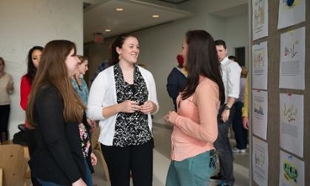Book project helps future teachers grasp abstract science topics
News
A group of upper-level biology majors is using their artistic talents to help future teachers get a better grasp of difficult science topics they will one day have to teach.
The biology students, who are taking a biological illustrations course, are assisting the learning process by illustrating books being written by the pre-service teachers who are taking a course called "Journey Through the Cell."
"These topics are really hard for these students," said Kerry Cresawn, an assistant professor of biology who began the book-writing assignment two years ago. "They're the invisible things in science—cells, DNA, processes you can't see and so they have a hard time grasping it and then find it hard to teach and so they quickly resort to textbooks and worksheets. They have an easier time explaining why leaves change color, more macroscopic, tangible things."
Writing the book is a side project to other coursework and the students, who are planning to teach at the middle school level, work in teams of four. "They're required to have a lot of adventure in it, but the adventure has to mesh really well with the science," Cresawn said, noting one group of students wrote a story about a boy who was shrunk by a machine so he could travel through a cell. "They have to embed misconception lessons in them without saying it's a misconception. The science has to be completely accurate."
Planning the artwork is an integral part of the project, Cresawn said. When she first assigned the project, she told students to figure out how to do the artwork. They could do it themselves or they could have a friend do it. "It worked out well because two students were very artistic and the others knew friends who were interested. In the second semester I had one artistic student the rest that draw like me," she quipped. "As I flipped through the books, I realized when they have a picture that tells a lot of science, they learn more."
This year, Cresawn's students teamed up with Dr. Alex Bannigan's art-biology students to get more science into the art and to improve the learning process for the pre-service teachers. Since the artists are upper-level biology majors, they understand what the pictures should show, Cresawn said. However, she made it clear that her students had to explain the science to be illustrated. "Sometimes my students get intimidated talking to the biology majors, but I think this helps their self confidence because they're having these conversations about really complicated stuff and it's an equal exchange."
At the end of the semester, Cresawn has the books, which average about 15 pages, bound for the students to keep. Next year, the project will expand a bit to include lesson plans at the back of the books. The lesson plans will be written by other pre-service teachers.
More information about the biological illustrations class is available here.

